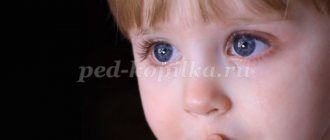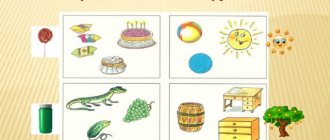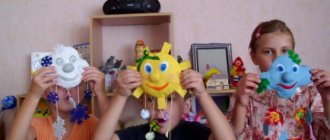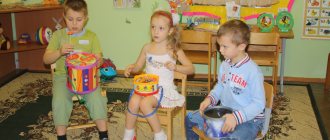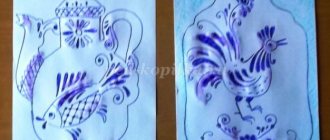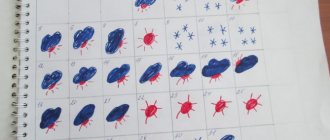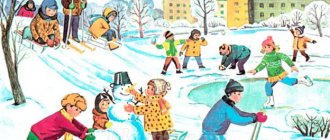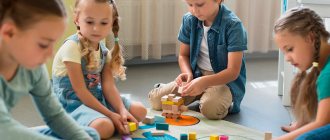Card index of walks "Winter" For older people
№ 27Comparative observation of bullfinch and waxwing
Target
– using the example of comparing the bullfinch with the waxwing, study the features of their structure, lifestyle (feeding, movement);
cultivate an educational interest in birds.
Conversation
Who has a breast brighter than the dawn? (At the bullfinch.)
Northern guests
Rowan berries are pecking at clusters.
So elegant and bright
There are tufts on the heads!
(Waxwing.)
What does a bullfinch look like? (The male bullfinch has a bluish-gray back, dazzling white undertail, black tail and wings, and a bright red breast. The female is more modestly colored - her breast is not scarlet, but dark gray.) What does a waxwing look like? (Her plumage is elegant, pinkish-brown, lighter on the chest and belly and darker on the back. The waxwing’s head is decorated with perky silver-pink crests.
And on the wings, as if drawn with a bright red pencil, there are even stripes.) What do they have in common? (These birds are migratory; bright plumage; they are residents of the north; they love rowan berries.) How does a bullfinch differ from a waxwing ?
(Size: the bullfinch is slightly larger than a sparrow, and the waxwing is the size of a starling, has a crest; plumage is colored.) Do we see these birds at feeders? Why? (These birds can be seen on rowan and viburnum bushes, as they feed on the berries and seeds of these plants.)
Is it possible to determine by the rowan berries scattered on the snow who fed on them? (Waxwings drop them on the snow, and bullfinches eat only the seeds, throwing out the pulp.) Do you know how bullfinches and waxwings behave? (Bullfinches leisurely fly in small flocks from tree to tree tree, slowly pecking at the berries. Waxwings are fast, nimble, timid; they fly in large flocks, pecking greedily and hastily.)
Work.
Spreading sand on slippery paths.
P/n:
“Owls”, “Birdhouses”. Skiing.
Individual work. Didactic games.
“Decide.” "What's extra."
Finger gymnastics
"Bullfinch".
Independent play activity.
Games with snow.
№ 29
Crow and Magpie Watching
Target
– consolidate the idea of the bird world, know their characteristic features.
Conversation
Magpie-Crow
Looks From Above,
From above to the sky
From an upside down branch.
Guys, look what a guest we have on the site. (Crow.) What
do you know about her? What is her character like? Why don't people like crows?
What's positive about it? The crow is called the gray robber.
Many do not like crows for their impudence and thieving habits. But still
We don’t have a bird smarter, more cunning, more resourceful: it will open a package of milk, and soak a stale cracker in a puddle, and crack a walnut. And if anyone decides to get close to the crow’s nest, beware. Neighbors will gather from all over the area, and together they will drive away the uninvited guest with a loud croak. The raven is the largest of the crow family. Raven and crow are completely different birds. You won't even see them together. Raven is a forest bird. In many fairy tales the crow is called wise. Maybe because this bird lives up to a hundred years. Do you know crow relatives? (Rook, jackdaw, magpie.) What magpie? What are the similarities and differences between crows
and magpie? You know Magpie well. Forest inhabitants respect the magpie. She has a long tail, flies everywhere, hears everything, knows everything. A magpie chirped in the bushes - the animals became wary and hid
birds. "Danger, danger!" - the magpie chirps, and
everyone understands her language.
Work.
Collective work on site.
P/n:
“The Kite and the Hen”, “Don’t Get Caught”. Badminton game.
Individual work. Didactic games.
"Guess the figure." “Put the word together.”
Finger gymnastics
"Crow".
Independent play activity.
Sledging.
Card index of walks in the senior group “December”
Ice-strongman experience
- pour water into a bottle and put it in a snowdrift at the end of the walk, examine the bottle, it is cracked - the volume of ice is always greater than the volume of water from which it was made; learn to draw conclusions.
Labor activity
: Clearing the area of snow
Target:
reinforce ideas about the protective properties of snow.
Outdoor games:
“Entertainers”, “Firemen in training”
Target:
strengthen the ability to run, dodge a trap, crawl under an obstacle. "Find yourself a mate"
Target:
develop agility, balance, endurance, spatial orientation
Individual work:
Development of movements
Target:
learn to throw snowballs into the distance.
Games at the request of children
Walk 2
Bird watching in winter
Target:
to form an idea of bird life in winter; cultivate a desire to take care of birds, highlighting signs of living things.
Progress of observation
There are no paths visible in the forest, fly, birdie, to people
The bushes are standing in sheepskin coats. And quickly hide outside the window,
Dormant beetles and larvae And we will feed you
Covered by snowfall under the bark. Bread crumbs, millet.
What birds do you see near your home in winter?
Why do they fly to human habitation? Why do people set up bird feeders in winter? Why do wintering birds need to be fed? Do many birds come to our feeders? What kind of food do they eat more readily? What else did you see while watching the birds at the feeder? Is there a feeder near your house?
Labor activity:
Clearing the area of younger preschoolers from snow.
Target:
cultivate a desire to help younger people.
Outdoor games :
"Cunning Couple"
Target:
develop your eye, achieving good results.
"Hit the target"
Target:
learn to follow the direction of a flying object, calculate and perform movements. "Frost - Red Nose"
Target:
learn to deftly and quickly run across the site;
Drawing
“Snow Artist” - Paints can be splashed on the snow and then sculpted from it. Or spray ready-made figures. Or just draw a picture directly in the snow.
Target:
develop creativity and imagination
Individual work:
Throwing snowballs into the distance and at the target.
Target:
develop coordination of movements.
Games at the request of children
An evening walk
Zimushka - winter
Target:
systematize children’s understanding of the characteristic signs of winter, and be able to talk about it beautifully.
Progress of observation
Who whitens the clearings with white, Sews feather beds,
And writes on the walls with chalk, Decorated all the windows?
Who knows the answer? What can you tell us about winter? (Cold, harsh, frosty, fierce, blizzard, angry, long.) After what does winter come? Name the winter months. What happens in nature in winter? What kind of trees are there? What lies on the roofs of houses and on the street? What do people wear in winter? How do animals and birds live in winter? Why? How can you help them? What winter holidays do you know? Children, think about how you can say beautiful things about snow and trees? (The snow lies in a wavy carpet and shimmers, sparkles, sparkles from the sun’s rays. There is fluffy, white, soft snow around and sparkles with multi-colored lights. Winter has dressed the trees in warm snow coats.) Now let’s come up with a story about the beauty of the winter forest. You must talk about the weather, the snow, the beauty of the trees, and what mood
Winter walk in the senior group. Abstract
Summary of a winter walk in the senior group of a kindergarten on the topic “Observing snowfall”
Author: Marina Viktorovna Vitskova, teacher of the MBDOU “Kindergarten “Goldfish” of the Astrakhan region, Chernoyarsk district. Description: using this material, children develop observation, curiosity, and attention. This material will be useful for parents and kindergarten teachers when conducting winter walks for older children. Goals: Continue to introduce natural phenomena; to develop cognitive interest and the ability to observe the world around them. Types of activities: gaming, cognitive-research, communication, basic household work. Materials : shovels, buckets, toys for children.
Progress of the walk
Watching snowfall.
Educator. Guys, look and tell me how it snows? Children. Snow falls to the ground quietly, snow falls in different directions. Educator. Snow is falling - this phenomenon is called snowfall (snow falls in flakes, snowflakes slowly fall on trees, on the roofs of houses, on the ground). Look how big the snowdrifts are on our site. Let's do an experiment with you. Why is the snow light? Children. The snow is soft, white, fluffy.
Conducting the experiment: “Why is the snow light?”
Goal: Improve children's knowledge about snow. Educator. Guys, let's shovel the snow into a pile with buckets. Now tell me, which snow buckets are light or heavy? Children. Snow buckets are lightweight. Educator. Remember, your children used to carry buckets of sand in the summer. Which sand bucket was light or heavy? Children. Sand buckets are heavy. So what about snow? Children. Snow is lighter than sand. Educator. What else could be heavier than snow? Children. Earth, water Educator. That's right, well done. Educator. Children, tell me what signs about snow do you know? Children. There will be a lot of snow - there will be a lot of bread. When the snow falls tightly to the fences - a bad summer. Snow sticks to the trees - it will be warm. The sun sets in the clouds - it will snow. It dawns quickly - it will snow. Clouds go against the wind - to the snow. Educator. What proverbs and sayings about snow do you know? Children. More snow in the fields means more bread in the bins. If a snowflake blows up, there will be more bread; if water spills, there will be hay. No matter how you wash, you will not be whiter than snow. Speeches are like snowflakes, but deeds are like soot. It’s not the snow that’s blowing, but the snow that’s coming from above. The first snowflake falls forty days before winter. Where there is snow, there is a trace: there was no snow, there was no trace. Educator. Well done boys.
Now tell me poems about snow. Children recite poems.
Here winter played snowballs, threw up a lot of snow, There is no way at all now, You can’t get through, you can’t get through!
In a snowy downy bed Pines are drowning, spruce trees are drowning... Everyone in the snow has become warmer, Snow is like a blanket for everyone! The first snow covered the ponds with ice. And the last rowan tree is pecked by blackbirds in reserve. Ice is transparent, fragile, thin - Don't go on the ice, child! White, delicate fluffy snow is spinning, falling, flying! White, sparkling pure, Lies on the ground, sparkling! Gently covers the earth, flutters in the air in a whirlwind! Dresses everything up with itself, amazes with beauty! The snow casts a spell, it snows, the snow blows snow... It swirls in the air, does not melt, It turns silver and sparkles... He wants to create magic, He will prophesy a fairy tale for us... The snow swirls, the snow swirls And lies on the fields All the roads are swept away This snowy winter The kids really like it Play sometimes have a snowball fight Ride on a sled Straight from the icy hill, Take skates or skis with you And rush to the skating rink, or to the forest! Educator. Guys, guess the riddle.
Mystery.
All day long, he flew, turning white, to the boulevards and alleys, lay down in the snowdrifts for the night... You guessed it!
This…. Children. Snow
Individual work.
Exercise children in throwing snowballs at a distance with their left and right hands.
Labor activity. “Remove snow from the paths” Goal: to involve children in performing simple tasks.
Game activity.
An outdoor game is being played: “Hunter and Hares” Purpose: to learn to throw a ball at a moving target. Progress of the game: On one side there is a “hunter”, on the other there are 2-3 “hares” in drawn circles. The “hunter” walks around the area, as if looking for traces of “hares,” then returns to his place. The teacher says: “The hares ran out into the clearing.” "Hares" jump on two legs, moving forward. At the word “hunter”, the “hares” stop, turn their backs to him, and he, without leaving his place, throws the ball at them. The “hare” that the “hunter” hit is considered shot, and the “hunter” takes it to himself. Educator. Children, did you enjoy the walk? What did we learn about snow today? What did you like most? Children talk about what they did, what they learned new, what they would like to learn more.
We recommend watching:
Summary of a lesson on the surrounding world for the senior group “Hello, Zimushka-Winter!” Summary of a lesson for older preschoolers “Hello, winter - winter” Summary of GCD in the senior group: How animals prepare for winter Summary of GCD on cognitive development in the senior group on the topic: Winter
Similar articles:
Walk “Wind Watching” in the senior group
Summary of the lesson “Birds in winter.” Senior group
Summary of a lesson on ecology in the senior group in kindergarten. Birds in the forest
Summary of a music lesson in kindergarten in the senior group on the topic: Winter
Entertainment “Visiting Winter” in kindergarten in the senior group
Card index of winter walks in the middle group
In the Russian Federation, all educational programs for preschool organizations are consistent with the Federal State Educational Standard (FSES) - federal state educational standards. They provide:
- Unity of the educational system.
- Continuity of training programs.
- Spiritual and moral education.
Walk in a medium group in winter
A walk in kindergarten in winter begins with proper organization. The teacher asks about the time of year.
Additional Information! Children find signs of winter in the surrounding nature. Riddles are asked. The weather condition is noted. A winter walk in a dhow in winter should be as productive as possible.
Observations during a walk in the middle group in winter are described in detail in the card index.
Card index of walks. December
| December | Observation on a walk: middle group, winter-December. | Didactic game | Outdoor game | Individual work | Work |
| day 1 | Trees. The teacher draws the children's attention to the snow covering the trees. | “The most attentive!” - develops hearing and perception of verbal instructions. | “Step over the stick” - trains children to step over an object. | Run along the line. | Clearing paths and paths of snow. |
| day 2 | “What changes have taken place on the street?” - formation of elementary ideas about changes in nature in winter, speech development. | “Fluffy bunny in a snowdrift” - repeat the movements after the teacher. | “Where does the sound come from?” - develops auditory attention. Definition of sound. Orientation in space. | Game "Find the toy." Learning to walk in the direction told by the teacher. | “We remove snow with shovels.” |
| day 3 | Snowfall. Grove. Forming an idea of the weather. New words: beautiful, snow, winter, spinning, cold. | “Run back and forth”: children run in the indicated directions. | “Quiet-loud” - develops the voice. Ability to speak either quietly or loudly. | Repetition of M. Poznansky’s poem “It’s snowing.” | Removing cones from the area. |
| day 4 | Birds. Feeding. Nurture care for birds. | “Quiet than everyone else?” Walking on toes. | "The secret is in the bag." Children determine the type of grains by touch. | “Fast legs walked along the road...” Develops coordination. | Hanging feeders. Education about caring for birds. |
| day 5 | Cats. Involving supervision of pets. Cultivate care for them. | Physical exercise. "Catching up." The lesson is aimed at strengthening physical health. | “Bring it and find it.” Develops in children a sense of responsibility in relation to the teacher’s requests. | Jumping in one place. | "Cleaning the gazebo." |
| day 6 | “Winter is winter.” "Our kindergarten in winter." Strengthen ideas about snow, winter, frost. | “The New Year is coming to us.” Comparison of winter, snow with the holiday. | “Yes and no” - reinforce the rules of behavior when walking in winter. | Repetition of poems for the New Year holiday. | Raking snow into a pile - preparation for making buildings from snow - involves children in labor. |
| day 7 | Passers-by. Children's attention is drawn to passers-by with packages, gifts, and Christmas trees. Everyone is waiting for the holiday. | “Find the same thing.” Mindfulness training. | "Beautiful Christmas tree." Children imitate a Christmas tree. | High jump. | Decoration of buildings with multi-colored ice floes. A desire to decorate the garden area is fostered. |
Note! A winter walk is held in kindergarten according to the requirements of the Federal State Educational Standard.
Ability to manipulate objects while playing with snow
Card index of walks. January
| January | Observation on a walk: middle group, winter-January. | Didactic game | Outdoor game | Individual work | Work |
| day 1 | Weather changes. The idea of winter | "Wind and Snowflakes." Action as directed. | "Blizzard-winter." Imitation of wind sounds. | “Walk straight along the path.” | Removing branches from the area. |
| day 2 | Passers-by's clothes. Why is everyone dressed so warmly? The connection between cold weather and clothing. | “The little bunny is running” - Children learn to follow the teacher’s movements, clap, jump. | “Tick-tock” - Correct pronunciation of “k”, “t”, “i” is developed. | Poem by N. Sakonskaya “Where is my finger?” Teach agility and speed. | Sprinkling paths with sand - explain to children. Explain why sand is needed on the paths. |
| day 3 | Birds. Teach a class of preschoolers how to care for birds in winter. | "The Crow and the Puppy." Actions on a signal. | "Little Helpers" Getting to know diminutive words. | Repeat poems about the Christmas tree. | Collect toys. |
| day 4 | Excursion to the forest belt. | "Throw the ball." Exercises in catching a ball at a distance of 100 cm. | "My first essay." Describe verbally what winter is. | Charging in frosty air. | Collect cones. Collect specified items from the snow |
| day 5 | Snow. Familiarization through games. | "The ball is rolling." Develop coordination in running and walking in the snow. | "Fox nose" Depict winter animals. | Walking in the snow. | "Sweep the gazebo" |
| day 6 | Birds. Taking care of them. Learn types. Recognize body parts. | "Mama Crow" | “What birds do you know?” Find the bird from the picture. | Imitation of birds. | Pour grains into feeders. |
| day 7 | Snow. Children's idea of snow. Guiding questions: “What can be done with it?”, “Where does it fall?”. | "Snow is flying." Teach children to pay attention to everything around them. | “There’s so much here.” Attention to surrounding objects. Pronounce the names. | Throwing snow. | Help the janitor clear the paths. Learn to help elders to each other. |
Drawing lesson on the topic “Beautiful Bird” in middle groups. Notes with card files must be certified by higher state stations. structures.
